Elsevier Encyclopedia of Geology - vol I A-E
Подождите немного. Документ загружается.


of the North Sea Basin and the Western Shelves
continued. During the Late Eocene and Oligocene,
reorganization of sea-floor spreading axes in the
Norwegian-Greenland Sea, the shelves of the British
Isles were destabilized by minor wrench faulting in
the prolongation of the Iceland ridge and the Charlie
Gibbs fracture zones, causing the subsidence of small
transtensional basins in the Irish Sea area (Figure 14).
Moreover, repeated pulses of basin inversion inter-
fered with the thermal subsidence of the Celtic Sea,
Western Approaches, and Channel basins (Figure 3).
During the Eocene, thrust-loaded flexural subsid-
ence of the foreland of the Western, Central, and
Eastern Alps, and also the Carpathian foreland, com-
menced. Oligocene to Miocene emplacement of the
East-Alpine and Carpathian nappe systems was, how-
ever, not accompanied by further intraplate compres-
sional deformation of their forelands, thus reflecting
mechanical decoupling of these orogens from their
forelands. By contrast, Late Eocene–Early Oligocene
and Late Oligocene–Early Miocene inversion pulses
evident in the Celtic Sea, Western Approaches, Chan-
nel, Weald, Sole Pit, Broad Fourteens, and West
Netherlands basins testify to intermittent and increas-
ing mechanical coupling of the evolving West and
Central Alpine Orogen with its foreland (Figures 3
and 14). Crustal shortening in the Western and
Central Alps persisted during the Late Miocene and
Pliocene, as evident by folding of the Jura Mountains,
and may indeed still be going on, as indicated by
earthquake activity and geodetic data.
In the Alpine foreland, development of the tec-
tonically still active European Cainozoic rift system
(ECRIS) commenced during the Late Eocene. Today
this rift system extends over a distance of more than
1000 km from the Dutch North Sea coast to the Medi-
terranean. Its southern elements are the northerly-
striking Limagne and the Valence and Bresse grabens,
which are superimposed on and flank the Massif
Central, respectively. These grabens are linked via
the Burgundy transfer zone to the northerly-striking
Upper Rhine Graben which bifurcates northwards
into the north-west-trending Roer Graben and the
north-easterly trending Hessian grabens that transect
the Rhenish Massif. The north-east-striking Eger
Graben, which transects the Bohemian Massif, forms
an integral part of the ECRIS (Figure 14). Localization
of ECRIS involved the reactivation of Permo-Carbon-
iferous shear systems. Although characterized by rela-
tively low crustal stretching factors, the evolution of
the ECRIS was accompanied by the development
of major volcanic centres on the Massif Central, the
Rhenish Massif and the Bohemian Massif, particu-
larly during Miocene and Plio-Pleistocene times. Seis-
mic tomography indicates that mantle plumes well up
beneath the Massif Central and the Rhenish Massif
but not beneath the Vosges-Black Forest arch; similar
data are, however, not available for the Bohemian
Massif. Despite this, the evolution of the ECRIS is
considered to be a clear case of passive rifting.
During the Late Eocene, the Valence, Limagne,
Bresse, Upper Rhine, and Hessian grabens began to
subside in response to northerly-directed compres-
sional stresses that can be related to the collisional
interaction of the Pyrenees and the Alps with their
forelands. These originally-separated rifted basins co-
alesced during their Oligocene main extensional
phase, and the Roer and Eger Grabens started.
During the Late Oligocene, rifting propagated south-
ward across the Pyrenean Orogen into the Gulf of
Lions and along coastal Spain in response to back-
arc extension, that was controlled by eastward roll-
back of the subducted Betic-Balearic slab. By Late
Burdigalian times, crustal separation was achieved,
the oceanic Provenc¸al Basin began to open, and the
grabens of southern France became inactive. By con-
trast, the intra-continental parts of the ECRIS
remained tectonically active until the present, al-
though their subsidence has been repeatedly inter-
rupted, possibly in conjunction with stresses
controlling far-field inversion tectonics. By end-
Oligocene times, magmatic activity increased on the
Rhenish Shield. At the same time, the area of the
triple junction between the Upper Rhine, Roer, and
Hessian grabens became uplifted, presumably in re-
sponse to thermal thinning of the lithosphere, inter-
rupting the Oligocene sea-way which had linked the
North Sea Basin with the Alpine foreland basin. By
Middle–Late Miocene times, the Massif Central, the
Vosges-Black Forest arch, and slightly later, also the
Bohemian Massif, were uplifted. This was accompan-
ied by increased mantle-derived volcanic activity. At
the level of the Moho, a broad anticlinal feature
extends from the Massif Central via the Burgundy
Transfer zone, the Vosges-Black Forest into the
Bohemian Massif (Figure 2). Uplift of these arches
probably involved folding of the lithosphere in re-
sponse to increased collisional coupling of the Alpine
Orogen with its foreland. Uplift of the Burgundy
transfer zone entailed partial erosional isolation of
the Paris Basin. Under the present north-west-directed
stress regime, which had developed during the Mio-
cene and intensified during the Pliocene and reflects a
combination of Alpine collisional and Arctic-North
Atlantic ridge-push forces, the Upper Rhine Graben
is subjected to sinistral shear, the Roer Graben is
under active extension, whilst thermal uplift of the
Rhenish triple junction continues. Moreover, the late
phase of accelerated subsidence of the North Sea
Basin, commencing in the Pliocene, as well as the
120 EUROPE/Permian to Recent Evolution
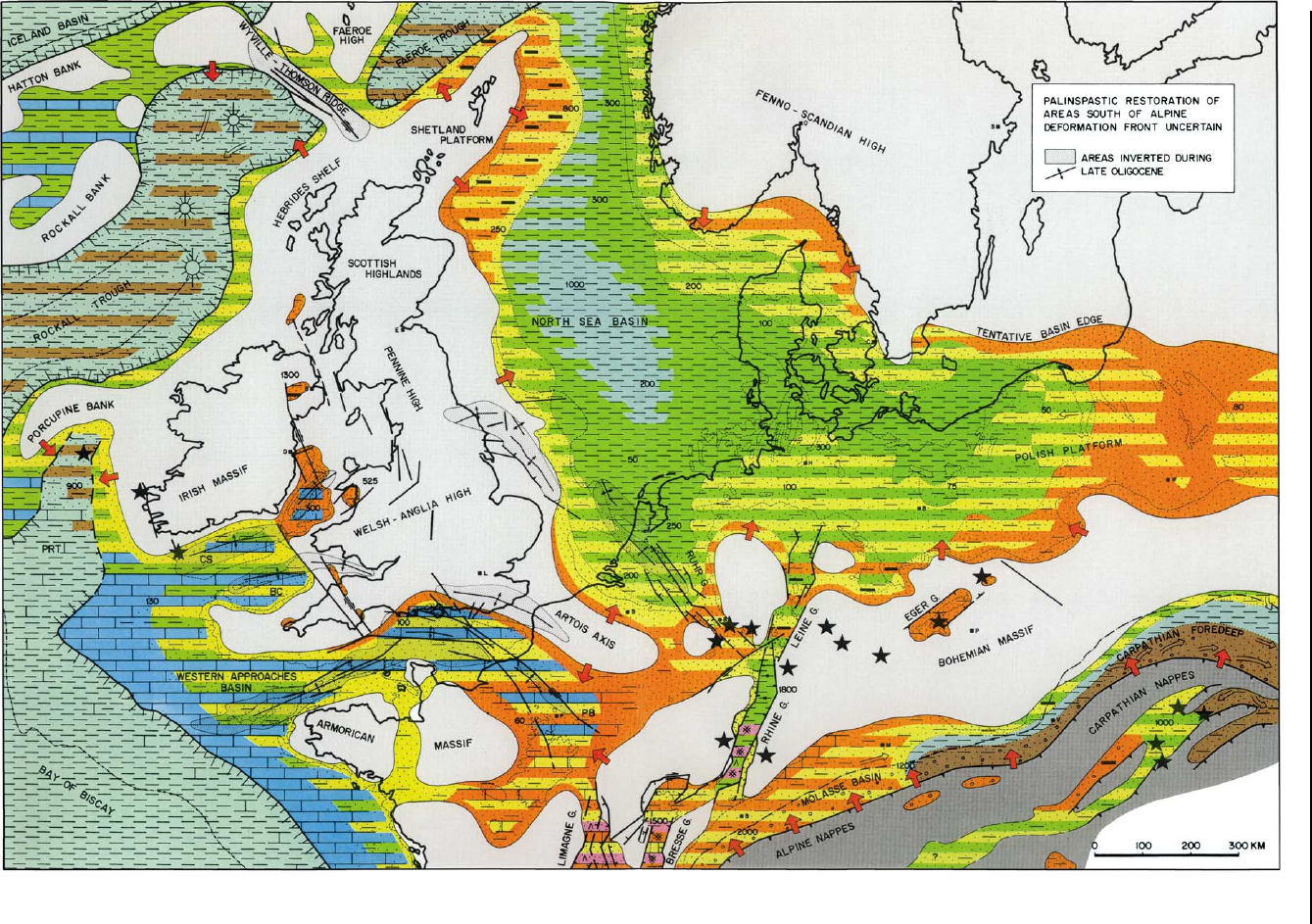
Figure 14 Oligocenepalaeogeography.Forlegendsee Figure 16.DetailsofEnclosurefrom Geological Atlas of Western and Central Europe2ndEdition,PeterA.Zeigler,1990,publishedby
Shell International Petroleum Mij. B.V., distributed by Geological Society Publishing House, Bath.
EUROPE/Permian to Recent Evolution 121
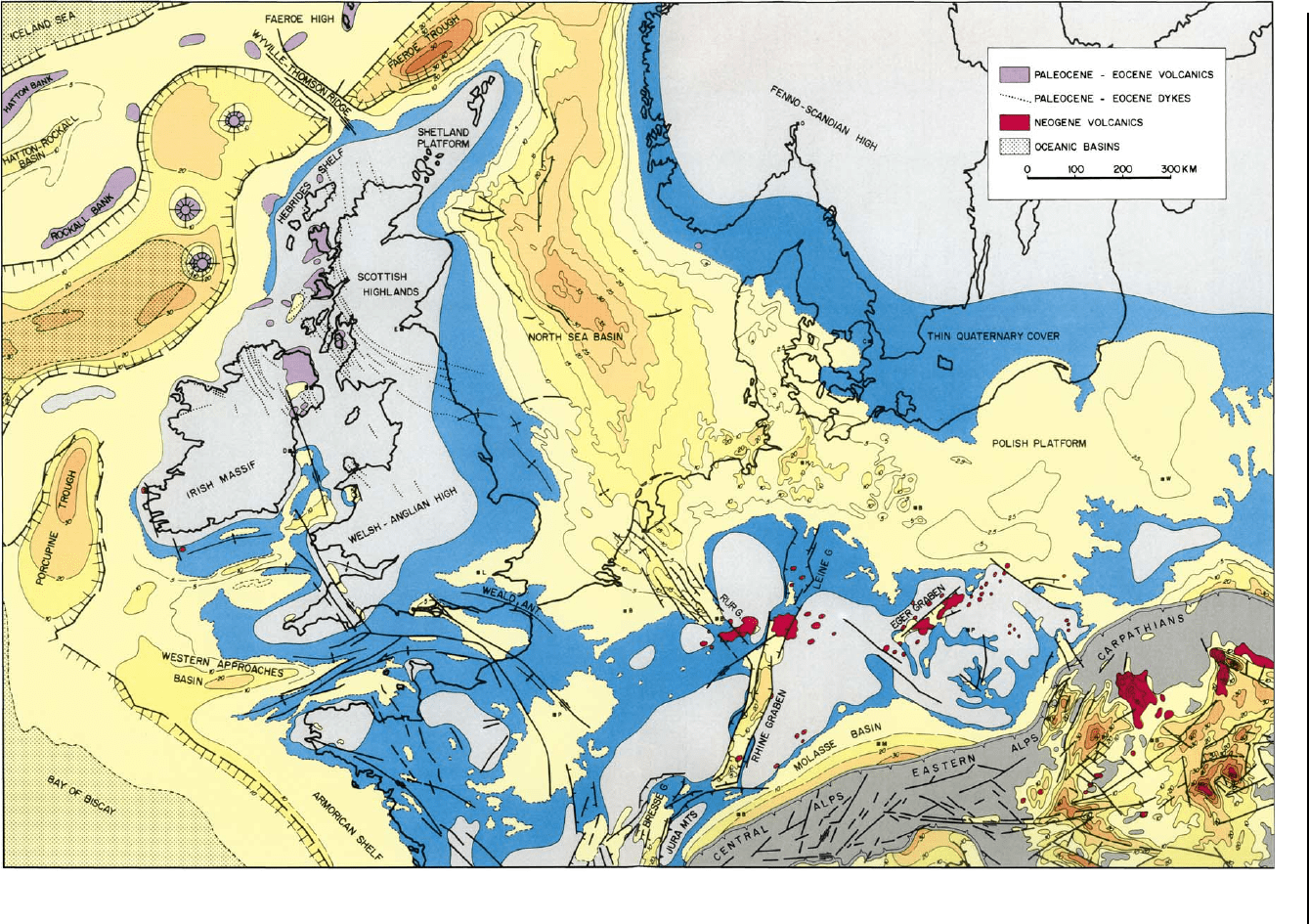
Figure 15 IsopachmapofCenozoicseries.Forlegendsee Figure 16.DetailsofEnclosurefrom Geological Atlas of Western and Central Europe2ndEdition,PeterA.Zeigler,1990,publishedby
Shell International Petroleum Mij. B.V., distributed by Geological Society Publishing House, Bath.
122 EUROPE/Permian to Recent Evolution

Figure 16 Legend to palaeogeographic, isopach and tectonic maps and to stratigraphic correlation charts.
EUROPE/Permian to Recent Evolution 123

contemporaneous uplift of the British Isles and the
Fennoscandian Shield, can be related to stress-
induced deflection of the lithosphere.
Progressive uplift of the Rhenish and Bohemian
massifs was coupled with the development of the
modern drainage system of Central Europe and the
shedding of massif clastics into the continuously
subsiding North Sea Basin in which water depths
gradually decreased. The Cenozoic isopach map
(Figure 15) illustrates the broad saucer-shaped
geometry of the North Sea thermal sag basin, the
axis of which coincides with the trace of its underlying
Mesozoic rift. This indicates that during Mesozoic
rifting not only the crust but also the mantle-litho-
sphere of the North Sea Basin were significantly
thinned (Figure 2). In contrast, Cenozoic sediments
are generally thin on the Polish Platform, which is
underlain by the deeply inverted Polish Trough that
is marked by a crustal root. In northern Germany,
sharp lateral Cenozoic thickness changes are related
to the growth of Permian salt diapirs. A comparison
of the present day erosional edges of Cenozoic
basins and their depositional margins (Figure 15)
illustrates the scope of Neogene to Recent uplift of
the WCE in response to basin inversion and litho-
spheric folding.
Resources
The Permian and younger sedimentary basins of the
WCE host a number of important hydrocarbon prov-
inces, the most outstanding of which are tied to the
Mesozoic North Sea rift system and the southern
margin of the Southern Permian Basin. The hydrocar-
bon systems of the North Sea rift, as well as of the
Faeroe trough, are largely tied to marine Kimmerid-
gian organic shales that charged reservoirs, ranging in
age from Devonian to Palaeogene, with oil and gas.
The gas-prone Southern Permian hydrocarbon pro-
vince relies for hydrocarbon charge on Westphalian
coal measures that were deposited in the Variscan
foreland basin. Organic deeper water Zechstein
shales and carbonates represent contributing source-
rocks. Main reservoirs are Rotliegend sands, Zech-
stein carbonates, and Triassic sands. Early Jurassic
marine organic shales control the petroleum systems
of the Paris and Channel basins, as well as of the
onshore parts of the North-west European basin in
the Netherlands and Germany. The oil and gas pro-
vince of the Aquitaine Basin relies for hydrocarbon
charge mainly on marine Kimmeridgian and Berria-
sian shales. Hydrocarbons occurring in the Alpine
foreland basin of Germany and Austria, as well as in
the Upper Rhine Graben, were mainly derived from
Oligocene marine shales.
Permian salts involved in diapric structures are
widely exploited in the onshore parts of the WCE.
Triassic salts are exploited in basins that are superim-
posed on Variscan crust. Polyhalites are associated
with the Zechstein halites in the Southern Permian
Basin and with Oligocene halites in the Upper Rhine
Graben.
See Also
Africa: Rift Valley. Europe: Caledonides of Britain and
Ireland; Permian Basins; The Alps. Fossil Invertebrates:
Cephalopods (Other Than Ammonites). Mesozoic: Trias-
sic; Jurassic. Moho Discontinuity.
Further Reading
BRGM, Societe
´
Elf-Aquitaine, Esso-REP and SNPA (1973)
Ge
´
ologie du Bassin d’Aquitaine. Edition Bureau de
Recherches Ge
´
ologiques at Minie
`
res, Paris (Atlas).
Boldy SAR (ed.) (1995) Permian and Triassic Rifting
in Northwest Europe. Geological Society of London,
Special Publication 91: 263.
Cooper MA and Williams GD (eds.) (1989) Inversion Tec-
tonics. Geological Society of London, Special Publication
44: 375.
Cope JCW, Ingham JK, and Rawson PF (eds.) (1992) Atlas
of Palaeogeography and Lithofacies. Geological Society
of London, Mem. 13: 152.
Dadlez R, Marek S, and Pokorski J (eds.) (1998) Palaeo-
geographical Atlas of the Epicontinental Permian and
Mesozoic in Poland. 1:2,500,000. Panstwowy Instiytuy
Geologiczny, Warsaw, 75 plates.
Debrand-Passard S and Courbouleix S (1984) Synthe
`
se
ge
´
ologique du sud-est de la France. Vol. 2. Atlas: Strati-
graphie et pale
´
ogeographie. Me
´
m. B.R.G.M. 126.
De
`
zes P, Schmid SM, and Ziegler PA (2004) Evolution of
the European Cenozoic rift system: interaction of the
Alpine and Pyrenean orogens with their foreland litho-
sphere. Tectonophysics (in press).
Glennie KW (ed.) (1998) Petroleum Geology of the North
Sea. Basic concepts and recent advances, 4th Edn.
Oxford: Blackwell Science.
Granet M, Wilson M, and Achauer U (1995) Imaging
mantle plumes beneath the French Massif Central.
Earth Planetary Scientific Letters 136: 199–203.
Kockel F (ed.) (1996) Geotectonic Atlas of NW-Germany,
1:300000. Hannover, Germany: Federal Institute for
Geosciences and Natural Resources.
Me
´
gnien C (1980) Synthe
`
se ge
´
ologique du Bassin de Paris.
Me
´
m. B.R.G.M. 102: Vol. 2, Atlas.
Parker JR (ed.) (1993) Petroleum Geology of Northwest
Europe. Proceedings of the 4th Conference. Geological
Society of London, Vol. 1 & 2: 1542.
Parnell J (ed.) (1992) Basins of the Atlantic Seaboard:
Petroleum geology, Sedimentology and Basin Evolu-
tion. Geological Society of London, Special Publica-
tion 62: 470.
124 EUROPE/Permian to Recent Evolution

Sissingh W (1998) Comparative stratigraphy of the Rhine
Graben, Bresse graben and Molasse Basin: correlation of
Alpine foreland events. Tectonophysics 300: 2249–284.
Stampfli G, Borel G, Cavazza W, Mosar J, and Ziegler PA
(eds.) (2001) The Paleotectonic Atlas of the PeriTethyan
Domain. CD-ROM, European Geophysical Society.
Ziegler PA (1988) Evolution of the Arctic-North Atlantic
and the Western Tethys. American Association Petroleum
Geology, Mem. 43; 198 p. and 30 plates.
Ziegler PA (1990) Geological Atlas of Western and Central
Europe, 2nd Edn., Shell International Petroleum Minj.
B.V., distrib. Geol. Soc., London, Publishing House,
Bath, 238 p. and 56 encl.
Ziegler PA, Bertotti G, and Cloetingh S (2002) Dynamic
processes controlling foreland development – the role of
mechanical (de)coupling of orogenic wedges and fore-
lands. European Geophysical Society, Stephan Mueller
Special Publication Series 1: 29–91.
The Alps
O A Pfiffner, University of Bern, Bern, Switzerland
ß 2005, Elsevier Ltd. All Rights Reserved.
Introduction
The Alps as a Mountain Belt
The European Alps, a mountain chain with elevations
reaching almost 5000 m, stretch from Nice to Vienna.
The highest peak, Mont Blanc, reaches an elevation
of 4807 m. Mont Blanc is part of a belt of granites
that stretches from the Pelvoux massif in France to
the High Tauern in Austria. The chain runs north–
south from Nice, on northward, forming a 90
bend
in Switzerland and then continuing eastward to-
wards Vienna (Figure 1). It is narrowest in the
transect of Switzerland. The mountain chain is dis-
sected by numerous deeply incised valleys, some of
which run parallel to the chain. To the north
of the Alps, the Danube system drains into the Black
Sea, the Rhine system drains into the North Sea, and
the Rhone system drains into the Mediterranean.
South of the Alps, the Po system drains into the
Adriatic Sea.
The North-Alpine foreland basin, called the
Molasse basin, stretches along the north side of the
Alps. It was filled by sediments carried in by the rivers
draining the Alps northward between 34 and 10 Ma.
Similarly, the Po basin to the south of the Alps re-
ceived the sediments from the Apennine chain and
from the rivers draining the Alps southward. Both
basins formed during the building of the mountain
chain. The weight of the mountain chain flexed the
tectonic plates on either side, creating depressions
that readily filled and became shallow seas. Up to
35 km of rocks were eroded from the growing Alpine
chain and accumulated in these depressions. Judging
from the nature of the accumulated sediments,
denudation of the growing chain kept pace with
the vertical uplift. The rising mountain chain was
probably never much higher than it is today.
Major Tectonic Units
The Alps formed as a result of the collision of the
Eurasian and African plates, two continental tectonic
plates that were initially separated by ocean basins.
Starting around 100 Ma, these two plates moved
closer to each other, closing the ocean basins between
them and ultimately colliding. Consequently, on pre-
sent-day tectonic maps of the Alps (Figure 2), it is
possible to distinguish between rock suites pertaining
to one or the other of these continents, or the ocean
basins between them. The Helvetic zone, Jura Moun-
tains, and the area north and west of the Alps pertain
to the former European margin of the Eurasian Plate;
the Austroalpine and Southalpine zones are parts of
the former Adriatic margin of the African Plate. The
Penninic zone is made up of sediments that accumu-
lated in ocean basins that were located between the
two continents, as well as the crustal rocks underlying
these basins. During the closure of these basins and
the ensuing collision of the two continental plates, the
European margin was dragged down south-eastward
beneath the Adriatic margin. The Eastern Alps are
dominated by rocks of the upper plate, the Adriatic
margin (Figure 2). Erosion has removed this upper
plate almost completely in the Central and Western
Alps. However, erosional remnants (termed ‘klippen’)
of the upper plate in the Western and Central Alps, as
well as pebbles carried out into the foreland by an-
cient rivers, prove that it once occupied much of the
entire Alps.
The ocean basins between the Eurasian and Adriatic
continental plates formed in response to the opening
of the Atlantic Ocean. Figure 3 shows the palaeo-
geography at 170 and 130 Ma. Two basins, the Valais
basin and the Piemont Ocean (sometimes called
the Liguria–Piemont Ocean), formed between the
European and Adriatic margins of the two contin-
ental plates. The two basins were separated by a
microcontinent, the Brianc¸onnais swell, which was
connected to the Iberian Peninsula at the time. Plate
EUROPE/The Alps 125
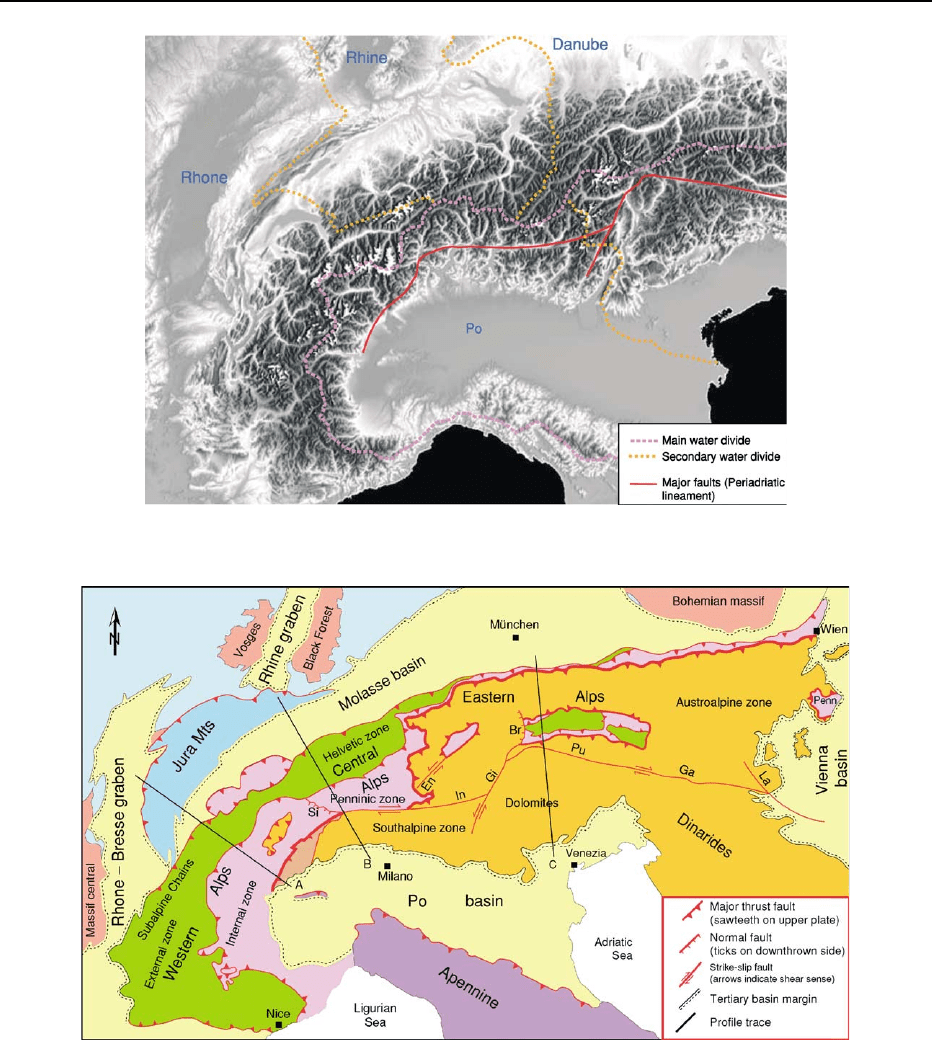
movements during the opening of the Atlantic were
such that the African plate moved eastward relative to
the Eurasian plate, and both plates moved away from
the North and South American plates. At an early
stage (around 170 Ma), this sinistral plate movement
occurred along a fracture zone that passed through
Gibraltar. This opened the Piemont ocean in the area
of the future Alps. At a later stage (around 130 Ma),
when the opening of the Atlantic had proceeded
further north, the sinistral movement occurred along
a fault zone passing north of the Iberia–Brianc¸onnais
continental fragment along the Gulf of Biscay.
This opened the Valais basin in the area of the future
Alps.
The fate of the Piemont and Valais basins was
controlled by convergence between the Eurasian and
Figure 1 Digital elevation model, showing the large-scale geomorphic features of the Alps and surrounding areas.
Figure 2 Tectonic map of the Alps, showing the major tectonic units. Sites A, B, and C correlate to orogen profiles A, B, and C in
Figure 4. Faults: Br, Brenner; Si, Simplon; En, Engadine; In, Insubric; Gi, Giudicarie; Pu, Pustertal; Ga, Gailtal; La, Lavanttal.
126 EUROPE/The Alps
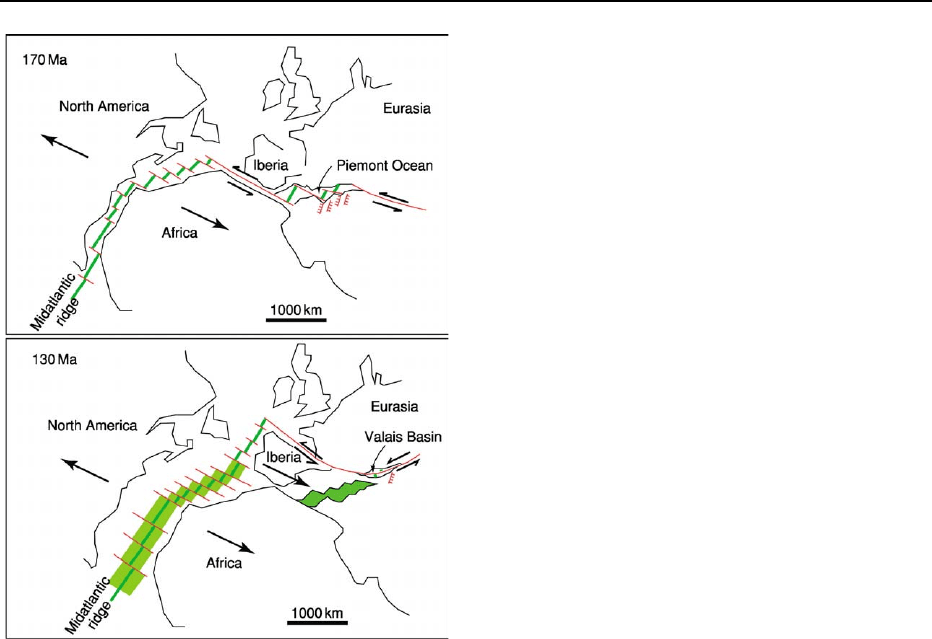
African plates. During this convergence, the basins
were subducted beneath the Adriatic margin and
were closed. Their lower part (the lithospheric
mantle) was subducted and recycled into the mantle.
Their upper parts (the crust and the sediments de-
posited in the two basins) were compressed and in-
corporated into the growing Alpine Orogen, where
they now form the Penninic nappes. The European
and Adriatic margins were also compressed during
convergence and collision of the two plates. Conse-
quently, the Helvetic nappes and the Jura Mountains,
both of which consist essentially of Mesozoic shelf
sediments, were formed on the European side. Simi-
larly, the Austroalpine and Southalpine nappes repre-
sent the deformed Adriatic margin of the African
plate.
Rock Types
When discussing the rock types that can be found in
the Alps, it is useful to distinguish between rocks that
formed prior to the opening of the Piemont and Valais
basins and rocks that formed during and after the
opening of the basins. In terms of Alpine geology,
the older rocks are referred to as basement. This
basement consists of two major units, crystalline
rocks (granites and polymetamorphic gneisses and
schists) and Palaeozoic sediments and volcanics, that
pertain to mountain belts formed at 300 to 400 Ma.
Granitic rocks are resistant to erosion, thus it is no
surprise that they form many of the higher peaks in
the Alps (including Mont Blanc).
The younger rocks are Mesozoic and Cenozoic
sediments and volcanics ranging in age from 225 to
10 Ma. Large quantities of carbonates accumulated
along the shelf seas of the continental margins, reach-
ing thicknesses of more than 1 km. These carbonates
now form the high cliffs that dominate the present-
day morphology of the Alps. Sandstones and shales
accumulated as basins on the continental slopes. In
some instances, these basins were flanked by faults
that formed in response to the breakup of the contin-
ents. Breccias accumulated at the foot of the steep
fault scarps. The deepest part of the basins consisted
of newly formed oceanic crust. Deep-sea sediments
(radiolarian cherts) slowly covered the basaltic lava
flows of the newly formed ocean floor.
Deep Structure of the Alps
A number of experiments have been designed to
image the structure of the Alps to depths of over
50 km. Dynamite detonations and vibrator trucks
located over a subsurface target generate seismic
waves that travel downward and then are reflected
back upward at various discontinuities in the Earth’s
crust. The upward-reflected waves (or echoes) are
recorded by a surface array of geophones and pro-
cesed into a coherent 2-dimensional image. The
resulting seismic sections can then be interpreted in
terms of subsurface geological structure. Figure 4
summarizes the findings for three transects through
the Alps.
Western Alps
Within the framework of ECORS-CROP (CROP ¼
CROsta Profonda ¼ Deep Crust; ECORS ¼ Etude de
la Crou
ˆ
te Continentale et Oce
´
anique par Re
´
flexion et
Re
´
fraction Sismiques ¼ Study of the continental and
oceanic crust by reflection and refraction sesimics), a
joint project between France and Italy studying the
deep continental crust by reflection and refraction
sesimics, researchers have profiled a transect across
the Western Alps (site A in Figure 2). The profile in
Figure 4A summarizes the findings of the ECORS–
CROP project. The Western Alps have an asymmetric
structure. On the European margin, i.e., in the west-
ern part of the Alpine orogen, the crust–mantle
Figure 3 Palaeogeographical maps at 170 and 130 Ma, show-
ing the future Alpine domain in the framework of the associated
tectonic plates. Opening of the Piemont Ocean and the Valais
Basin was closely linked to the opening of the Atlantic.
EUROPE/The Alps 127
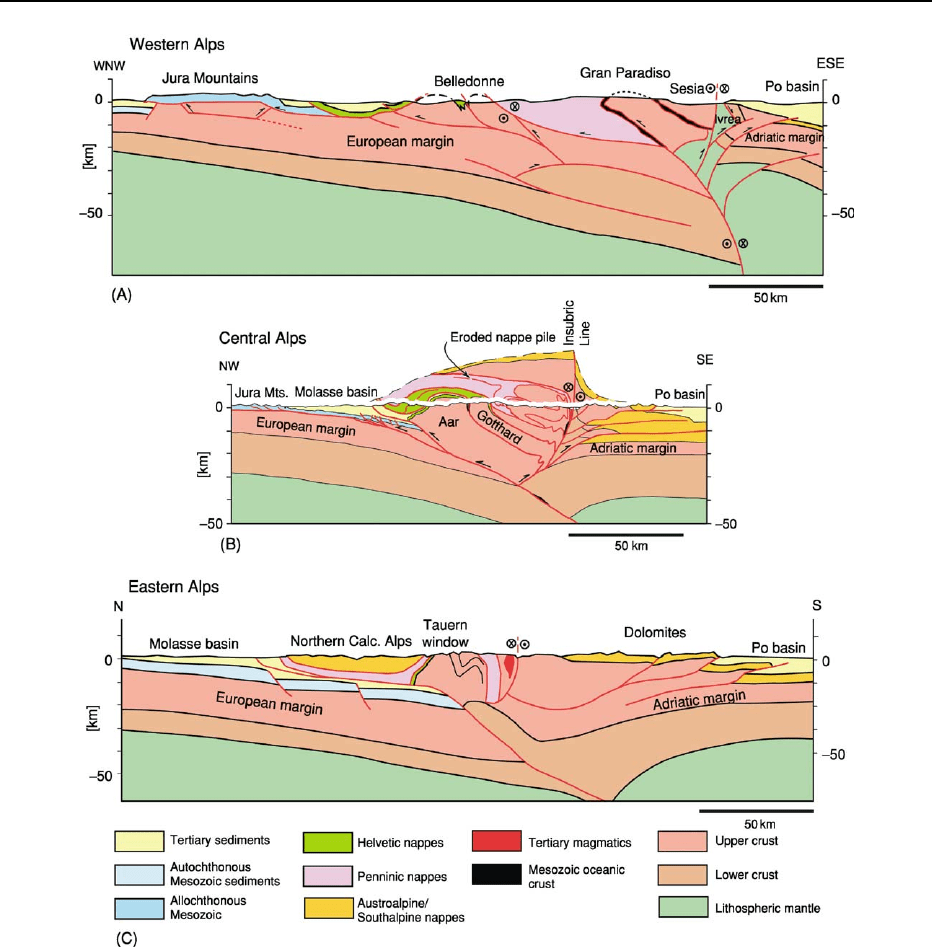
boundary dips to the east, attaining depths exceeding
50 km beneath the orogen. Much of the crustal root is
made up of lower crust, which appears to be tripled in
this transect. This stacking was accomplished by
thrust faults that moved entire blocks of crustal
rocks upward towards the west. On the Adriatic
margin, on the other hand, the crust–mantle bound-
ary rises towards the surface, proceeding westward.
This rise is accentuated by several thrust faults, which
also affect the lower crust. In the case of the Ivrea
zone, these lower crustal rocks and pieces of
the mantle actually outcrop at the surface. The
asymmetric structure of the Western Alps is a conse-
quence of the collision of the Adriatic and European
margins resulting from the convergence of the African
and Eurasian plates. The ocean basins located be-
tween the two margins were highly deformed by
these plate movements. The sediments, as well as
their crustal substrate, were compressed, shortened,
and stacked. These rocks now form the Penninic
nappes shown in Figure 4A. The upper crust of the
European margin was also shortened and thickened
in the process of collision, forming a large-scale base-
ment uplift (the Belledonne massif) within the Alps.
Figure 4 Three profiles through the Alps, showing the deep structure of the orogen. The profile sites are shown in Figure 2.
(A) Transect through the Western Alps of France and Italy. (B) Transect through the Central Alps of Switzerland and Italy. (C) Transect
through the Eastern Alps of Austria and Italy. See text for discussion.
128 EUROPE/The Alps

Further out towards the foreland, shelf sediments of
the European margin were detached from their sub-
strate, shortened by folding and thrusting, and trans-
ported towards the west. They now form the Jura
Mountains. In addition to all of the thrusts and
folds that represent WNW–ESE shortening, there
were substantial movements in and out of the plane
of the section shown in Figure 4A. These movements
were related to strike–slip motions that displaced the
Adriatic margin towards the north relative to the
European margin.
Central Alps
Investigation of the Central Alps by the Swiss Na-
tional Research Project (NRP) 20 has provided results
complementary to those of the European GeoTra-
verse (EGT). The EGT study assessed the continental
lithosphere that runs from the North Cape across
Europe to Tunisia. Several transects were profiled
across and within the Swiss Alps. Figure 4B, a profile
along the central traverse of NRP 20, has been
extended to include the Jura Mountains and the Po
basin. As with the Western Alps, the asymmetric struc-
ture of the Central Alps evolved during convergence
between Eurasia and Africa. The lower crust of the
European margin extends at constant thickness be-
neath the Adriatic lower crustal wedge. The tip of the
latter is exposed at the surface. The centre of the orogen
consists of European margin upper crustal rocks that
were stacked by thrust faults during plate convergence
and collision. The associated heat and pressure trans-
formed the rocks: granites became orthogneisses, sedi-
ments became paragneisses, and limestones became
marbles. The mineral assemblages ‘‘frozen’’ in these
metamorphic rocks allow determination of the tem-
perature and pressure paths these rocks took during
collision and the ensuing denudation.
Along one major fault, the Insubric Line, the nappe
stack was moved upward and southward, but erosion
kept pace with this uplift and removed a large section
of the Austroalpine and Penninic nappes. Studies of
the rocks outcropping at the surface indicate that they
were once buried to depths exceeding 25 km. Strike–
slip motion along the Insubric Line moved the Adri-
atic margin westward relative to the European
margin in the later stages of the collision. In the
north-western part of the orogen, the thrusting was
chiefly towards the north-west. Conversely, thrusting
was directed towards the south-east in the south-
eastern part of the orogen. In both cases, the sequence
of thrusting was from the centre of the orogen to-
wards the forelands. This can be interpreted as
the result of the collision of the European and Adri-
atic continental margins. Deformation of the crust
occurred within the zone of contact and the deformed
rocks were shoved on top of each other to form an
orogenic wedge, similar to the wedge of snow
forming in front of a moving snowplough. Short-
ening related to plate convergence and collision is
particularly accentuated along this transect of the
Alps. The associated uplift and erosion are indicated
by the high degree of metamorphism of the exposed
rocks outcropping at the surface. The focused hori-
zontal shortening (and vertical stretching) explain
why the Alpine chain is particularly narrow in this
transect.
Eastern Alps
The Eastern Alps have been studied in a joint project
(TRANSALP) between Germany, Austria, and Italy.
A seismic transect through the Eastern Alps and the
Dolomites has produced the seismic data and geo-
logical interpretations shown in Figure 4C. The
crustal structure of the Eastern Alps is rather different
from that of the western and central sections. The
European margin shows a thin slab of lower crust
dipping to the south. The Adriatic lower crust is
thicker and has a piece protruding into the European
upper crust. The upper crust of the European margin
forms a large-scale basement uplift that is exposed in
the Tauern window. The Helvetic nappes are virtually
absent in this transect and the Penninic nappes make
up only a proportionally small volume . The upper
crust of the Adriatic margin, on the other hand, is
much more voluminous. It is over 30 km thick and is
shortened by thrust faults. Important strike–slip
motions have displaced the Adriatic margin to the
west, relative to the European margin along the
Pustertal line.
Alpine Nappe Structures
Collision between the two margins of the Eurasian
and African plates, like the crash of two cars, led to
severe deformation (folding and fracturing) of the
rocks within the zone of contact. Large-scale frac-
tures in a zone of compression led to the formation
of thrust faults that transported entire crustal blocks
upward on a gently inclined fault surface. The dis-
placed blocks were typically several hundreds of
kilometres wide, 50–100 km long, and only a few
kilometres thick. These thrust sheets are termed
‘nappes’, from the French for ‘tablecloth’, because
of their shape. The (horizontal) shortening of the
continental crust also led to the folding of layers of
rock. The folds, which occur on every scale, from
millimetres to kilometres, are an expression of the
penetrative deformation of crustal rocks.
EUROPE/The Alps 129
